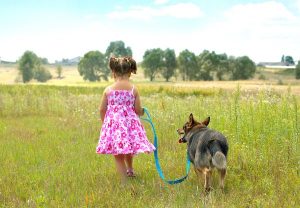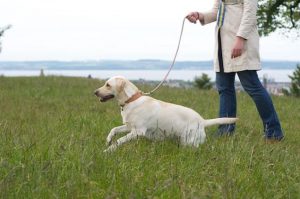This week we’re offering up tips to teach formal heeling. What is heeling exactly?
– Heeling is the most formal and precise way to walk a dog, and requires the most attention from our dogs. It’s incredibly useful when walking your dog through crowds or down busy streets, or when you’d like your dog to focus on you rather than on a potential four-legged friend. We can define heeling as the dog walking parallel to the handler, no more than six inches between dog and handler, and the dog’s ear (or shoulder) lined up with the handler’s leg.
– Left Side or Right Side? We often think of heeling as our dog walking on our left side. Why the left side? Well… we’re living in a mostly right-handed world, and most dog handlers are right-handed. Dog training has its roots in hunting, military, and herding traditions — so keeping a right hand free for guns or equipment has tremendous value. When a handler with a firearm has his or her dog on the left, this can also protect the dogs from ejected shells and cartridge cases. Last, having a dog heel on the left can keep him on the curb or at least further away from the flow of traffic. Bottom line… go with your preference and stick with that side consistently.
– Teach Heel Position You may have heard the term “finish” when attending a training class. Teaching a finish, or flip finish, can be accomplished by following the steps here. Like to see it in action? Watch the steps in this video. Really, really want to nail down heel position? Okay, we warned you… check this video out!
– Make Heeling Fun As Ian Dunbar has written, “For many dogs, unfortunately, on-leash heeling is the most unpleasant command (having the highest correction/command ratio of any other obedience instruction), so much so, that heeling around the block becomes a drag in both senses of the word. The dog must think there is a jerk at both ends of the leash.” Yikes! It really is possible for your dog to enjoy learning how to heel — just keep in mind that it isn’t necessarily natural for your dog AND that it takes a lot of practice for a dog to heel well. And on that note…
– Use Treats or Toys so that your dog is motivated to pay attention and to move with you. There are many variations on how to train heeling, and here’s a few: teach heel by training your dog to follow you off-leash first, teach heel by having your dog follow a lure, or teach attention then heeling by using a clicker. Have a small dog under 25 pounds? Check out these tips for working with your pint-sized pup!
By Susan Marett










